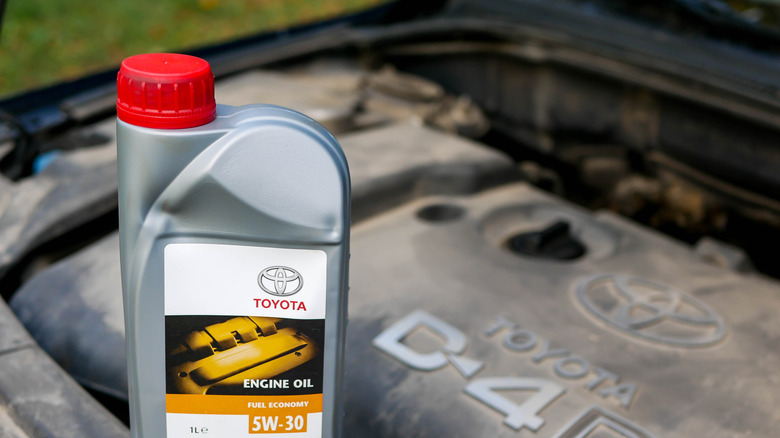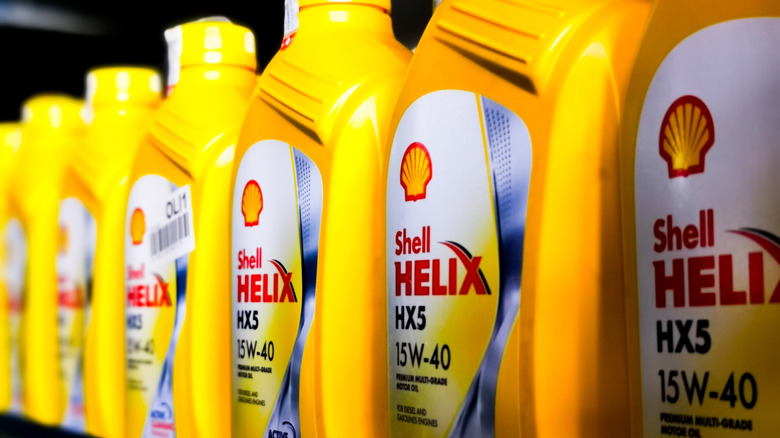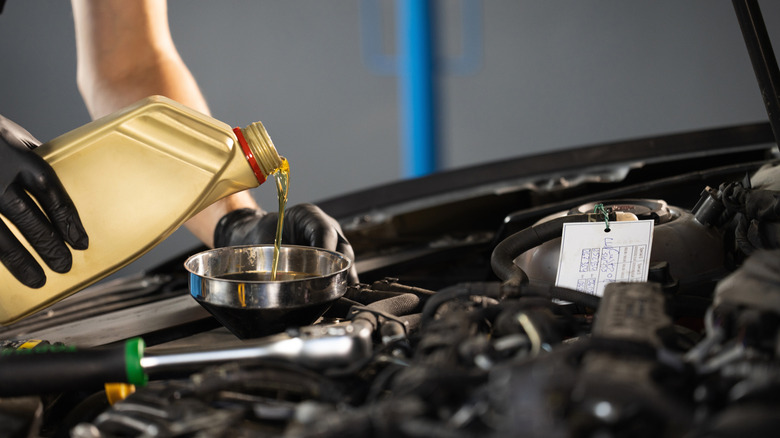What Does The W Stand For When It Comes To Engine Oil?
The numbers and letters on a bottle of motor oil can look like gibberish if you aren't sure how to decode them. 5W-30, 10W-40, 0W-20... What's this supposed to be telling you? Does the "W" stand for weight, weather, width, or what? In truth, the "W" doesn't represent any of those things. It stands for winter.
The letter "W" is tied directly to how the oil performs in colder conditions — especially during engine start-up, when lubrication is a really critical thing. The Society of Automotive Engineers (SAE) created the viscosity rating system more than a century ago to standardize oil performance. (Viscosity, or a liquid's resistance to flow, essentially refers to the thickness of the oil.)
The first number you see on an oil bottle, followed by the "W," tells you how well the oil flows in cold weather. The lower the number before the "W," the thinner the oil will be (and the faster it'll circulate throughout the engine) in low temperatures. For example, a 0W-20 oil would flow more easily in freezing temperatures than a 10W-30. The faster the circulation, the less wear on your engine during those crucial first seconds after you start the car.
What an engine oil's letters and numbers mean
Whereas the "W" tells you how the oil will act during cold starts, the second number tells you how the oil will perform once the engine warms up. For example: With a 5W-30 oil, the "30" tells you it'll rank on the thinner side of SAE's scale once it hits the standard operating temperature of 100°C/212°F.
Before the 1960s came around, drivers had to switch their oil every season. Thin oils were used in winter to keep engines lubricated in freezing weather, while thicker oils were swapped in for summer to protect engines under higher heat. Not only was it inconvenient, but it also left plenty of room for mistakes if the wrong oil ended up in the engine at the wrong time of year.
The introduction of multi-grade motor oil in the late '50s completely revolutionized this now-outdated approach. By putting viscosity modifiers into the oil, manufacturers effectively created products that could adapt to temperature changes. Modern-day multi-grade oils like 5W-30 can act like a low-viscosity oil in the winter while still giving you the thickness of a higher-viscosity oil once the engine reaches its operating temperature.
Choosing the right W grade for your engine
Cold starts are notoriously rough on an engine. The metal components are dry, the friction is high, and the temperature is nowhere near the standard for operation. That's why the colder your winter climate, the lower the number you should look for on the bottle. Likewise, you'll also want something thick enough to protect your engine parts at high temperatures. As a good rule of thumb, 5W-30 has become the most common recommendation for many modern vehicles.
If you're feeling lost, just look in your owner's manual. Manufacturers will list a recommended oil grade in line with your engine's very specific needs, and going off of their recommended oil grade will help you make sure your engine gets the right balance of flow and protection in all seasons. (Some manufacturers even list multiple acceptable grades in their manuals, depending on climate or driving style, meaning you could possibly interchange 10W-30 and 5W30 motor oils or some other combo.)


